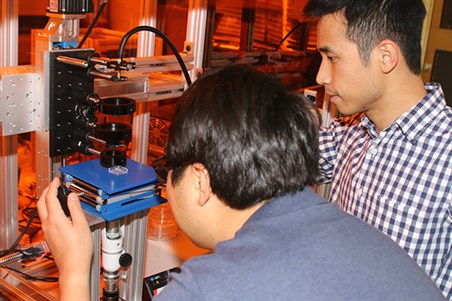 In 1989 Chuck Hull changed product design and manufacturing processes when he introduced the world to 3-D printing technology.
In 1989 Chuck Hull changed product design and manufacturing processes when he introduced the world to 3-D printing technology.
Hull was seeking to develop a low-cost manufacturing process that could be used in the modeling of prototypes and commercial products. The first item he manufactured was a small cup which could be used as an eye wash.
Three-dimensional printing is a manufacturing process where thousands of layers of thin plastic or metal are laid on top of each other to form intricate designs. Depending on the process, the objects are solidified either thermally or chemically. Three-dimensional-printed products can be more complex in shape and durable than those produced using traditional manufacturing processes.
Today faculty and students of the Department of Mechanical Engineering at Texas A&M University have access to 3-D printers in the department with the capabilities to print any design they can conceive. The 3-D Printing Studio provides students with the opportunity to learn and work on the same machines they will potentially work with in their engineering careers.
Although 3-D printing has advanced in the past 30 years the technology still has many limitations. To successfully make large objects, support structures which act similar to building scaffolding are often used. These structures are removed by hand trimming, high-pressure water blasting or solvent solution after printing. The challenge is mostly present in the 3-D printing of soft jelly like materials due to the difficulty of creating and removing support structures.
These soft materials could be used in the modeling of synthetic tissues which could prove instrumental in the advancement of biomechanical and biomedical research.
Dr. Bruce Tai, an assistant professor in mechanical engineering and director of the Manufacturing Innovation Laboratory at Texas A&M, and his students have developed a method that on a small scale eliminates the need for support structures and allows them to 3-D print soft objects.
The team developed a support-free fabrication processes by creating a hydrostatic condition inside of a polymer resin. By employing this technique the researchers will also be able to eliminate the traditional layer-by-layer printing technique for geometric soft structures.
Tai worked with Dr. Rocky Zhu of Dow Corning Corporation to test different non-commercialized silicone products’ curing properties when introduced to different UV wavelengths.
The experiment utilized a UV lamp system, an optical lens array, and a 3-axis motion stage. The entire setup was covered in amber plates to prevent affects from atmospheric UV lights.
“This is a cross-disciplinary research project involving polymer science, optics, fluid mechanics and machine design,” said Tai. “The challenge for our team as mechanical engineers was to integrate all the knowledge from the multiple concentrations to test, design and ultimately develop a new low-cost manufacturing process.”
A challenge the team faced was accurately curing a specific region of the silicone to create the soft geometric objects. The team had to obtain low one-photon polymerization (LOPP) inside the resin, as opposed to stereolithography where polymerization takes place on the resin surface. The liquid pressure around the cured object then holds the shape in position creating the hydrostatic condition needed to cure the target area of the silicon resin and form a precise three-dimensional geometry.
“An example similar to our technology is created when an individual dives into a swimming pool,” said Tai. “The zero-gravity environment created in the water causes the individual to feel weightless, lose no body mass and maintain form.”
To achieve the in-resin solidification, the team had to find the accurate UV wavelength, intensity, and exposure time needed to accurately cure the resin at the focusing spot with low one-photon polymerization.
“An improper setting caused the resin to polymerize either too fast or too slow,” said Tai. “We had to figure out how to accurately create LOPP in the silicone resin.”
By adjusting the UV light and testing different angles, focal lengths and silicone products Tai’s research eventually proved the feasibility of support-free fabrication process capable of 3-D printing of soft structures.
“There are currently commercial printers which have the capabilities to make soft materials, gel or even real tissues,” said Tai. “These printing techniques are either limited to low-profile shapes or require support structures. Our research provides a starting point for the future of unsupported 3-D printing.”